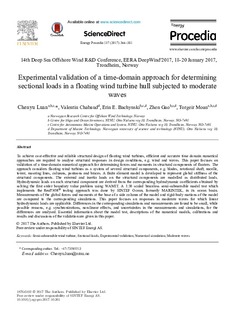| dc.contributor.author | Luan, Chenyu | |
| dc.contributor.author | Chabaud, Valentin Bruno | |
| dc.contributor.author | Bachynski, Erin Elizabeth | |
| dc.contributor.author | Gao, Zhen | |
| dc.contributor.author | Moan, Torgeir | |
| dc.date.accessioned | 2017-12-29T08:30:02Z | |
| dc.date.available | 2017-12-29T08:30:02Z | |
| dc.date.created | 2017-12-28T11:42:57Z | |
| dc.date.issued | 2017 | |
| dc.identifier.citation | Energy Procedia. 2017, 137, 377-381. | nb_NO |
| dc.identifier.issn | 1876-6102 | |
| dc.identifier.uri | http://hdl.handle.net/11250/2473846 | |
| dc.description.abstract | To achieve cost-effective and reliable structural design of floating wind turbines, efficient and accurate time domain numerical approaches are required to analyse structural responses in design conditions, e.g. wind and waves. This paper focuses on validation of a time-domain numerical approach for determining forces and moments in structural components of floaters. The approach considers floating wind turbines as a system of several structural components, e.g. blades, rotational shaft, nacelle, tower, mooring lines, columns, pontoons and braces. A finite element model is developed to represent global stiffness of the structural components. The external and inertia loads on the structural components are modelled as distributed loads. Hydrodynamic loads on each structural component are derived from the corresponding hydrodynamic coefficients obtained by solving the first order boundary value problem using WAMIT. A 1:30 scaled braceless semi-submersible model test which implements the ReaTHM® testing approach was done by SINTEF Ocean, formerly MARINTEK, in its ocean basin. Measurements of the global forces and moments at the base of a side column of the model and rigid-body motions of the model are compared to the corresponding simulations. This paper focuses on responses in moderate waves for which linear hydrodynamic loads are applicable. Differences in the corresponding simulations and measurements are found to be small, while possible reasons, e.g. synchronizations, non-linear effects, and uncertainties in the measurements and simulations, for the differences are analysed. Essential information about the model test, descriptions of the numerical models, calibrations and results and discussions of the validation are given in this paper. | nb_NO |
| dc.language.iso | eng | nb_NO |
| dc.publisher | Elsevier | nb_NO |
| dc.rights | Attribution-NonCommercial-NoDerivatives 4.0 Internasjonal | * |
| dc.rights.uri | http://creativecommons.org/licenses/by-nc-nd/4.0/deed.no | * |
| dc.title | Experimental validation of a time-domain approach for determining sectional loads in a floating wind turbine hull subjected to moderate waves | nb_NO |
| dc.type | Journal article | nb_NO |
| dc.type | Peer reviewed | nb_NO |
| dc.description.version | publishedVersion | nb_NO |
| dc.source.pagenumber | 377-381 | nb_NO |
| dc.source.volume | 137 | nb_NO |
| dc.source.journal | Energy Procedia | nb_NO |
| dc.identifier.doi | 10.1016/j.egypro.2017.10.361 | |
| dc.identifier.cristin | 1532390 | |
| dc.description.localcode | © 2017 The Authors. Published by Elsevier Ltd. This is an open access article under the CC BY-NC-ND license (http://creativecommons.org/licenses/by-nc-nd/4.0/). | nb_NO |
| cristin.unitcode | 194,64,20,0 | |
| cristin.unitname | Institutt for marin teknikk | |
| cristin.ispublished | true | |
| cristin.fulltext | original | |
| cristin.qualitycode | 1 | |

